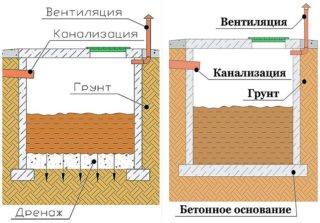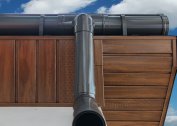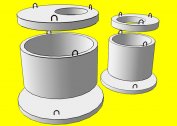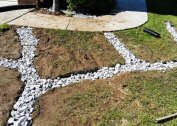For a comfortable stay in an individual building, the arrangement of a sewer system matters. To do this, you need to correctly determine the size of the cesspool for a private house.
Features of the arrangement of the cesspool
 In urban conditions, people enjoy all the benefits of civilization. Outside the boundaries of megacities, there is no running water and sewage. One of the pressing issues is the provision of wastewater discharge during the construction of a private house. The basic rule - during operation, the structure should not pollute the site and the environment.
In urban conditions, people enjoy all the benefits of civilization. Outside the boundaries of megacities, there is no running water and sewage. One of the pressing issues is the provision of wastewater discharge during the construction of a private house. The basic rule - during operation, the structure should not pollute the site and the environment.
In a private building, a cesspool is designed according to SanPiN 42-128-4690-8 and SNiP 30-02-97. The regulation provides for the following rules:
- Storage and cleaning tanks are located on the territory adjacent to the house, no closer than 10 m to the house.
- The distance to the water supply system is at least 10 meters, to the well or well –20.
- According to some standards, a cesspool is allowed to be installed at a distance of 5 meters from the premises, if the size of the plot is small.
- The system is located no closer than 2 meters from the border of the neighboring section.
- According to SNiP, the depth of the pit should not exceed 3 meters.
- The permissible distance from the bottom to the groundwater level is not less than a meter.
Besides:
- the design must have a sealed cage and the ground part, closed with a lid;
- filling the underground part is allowed no higher than 35 cm from the top of the pit;
- cleaning is carried out as it is filled, but at least twice a year.
- disinfection required.
The system should be located below the water well along the slope of the site. Wastewater from the house flows by gravity through pipes led to the pit.
Arranging a cesspool is not a complicated process, but laborious, as it is associated with earthworks. There are no special requirements for its appearance and design, since the entire system is located in the ground.
Design selection
Options differ in the material of manufacture and the principle of operation, the duration of operation. According to the principle of work, two main types are distinguished. The tight design consists of a closed bottom and strong walls. It can be single chamber or consist of several compartments. The tanks are interconnected by nozzles, equipped with biological filters, pumps. Such drain tanks do not harm the environment, but are quickly contaminated and require regular cleaning.
Pits without a bottom absorb accumulations by all layers of soil. One of the simplest tanks is a cesspool made of car tires. This is a budget option. It has a small volume, is not cleaned and quickly silted.
The life of a barrel tank depends on the quality of the metal. If you choose expensive material with a corrosion-resistant coating, the device will last for many years.
There are special plastic containers. If the pit is up to 1m3, polypropylene barrels can be used.
A brick structure becomes unusable due to the decomposition of the material under the influence of moisture. Walls can be repaired with concrete inserts, extending the life of the unit.
The best option for the ratio of quality and cost is concrete rings. They do not rot, are resistant to soil movement. The service life of such a device can be up to 100 years.
Calculation Rules
 Before erecting the structure, it is necessary to calculate the volume of the cesspool. You need to build on the number of constantly residing people in this building. A person uses about 150 liters of water per day. These are the costs of cooking, washing dishes, washing, shower and bath, as well as a toilet.
Before erecting the structure, it is necessary to calculate the volume of the cesspool. You need to build on the number of constantly residing people in this building. A person uses about 150 liters of water per day. These are the costs of cooking, washing dishes, washing, shower and bath, as well as a toilet.
A family of three will be drained into a cesspool per day: 3 * 150 = 450 liters. The sealed pit is cleaned every 15 days. In two weeks, 6750 liters or 6.75m3 of waste will accumulate. It is necessary to lay a reserve for unforeseen situations. The volume of the tank in this case will be equal to 9 m3. For a country house, where people stay for a short time during planting and harvesting, it is enough to have a capacity of 1–2 m3.
A device without a bottom is cleaned by anaerobic bacteria, and the effluent partially goes into the ground. Such designs also require periodic pumping. To extend the period allow special biological products. The calculation is carried out on the maximum possible volume of effluents.
To the average consumption of 150 liters per person, wastewater from household appliances that use water is added. Thus, the volume increases to 50 liters per day. A family of three has at least 600 liters of effluent. To determine the pit volume, the amount per day should be increased three times, and will be 1.8 m3.
Settlement of Parties
The required cubic capacity affects the parameters of the well. There are no clear rules for the aspect ratio. You need to calculate based on the depth of the groundwater. Depth of a hole of 2.5–2.7 meters is considered standard. The pit under the cesspool is a parallelepiped. The calculation of its parties is as follows:
Volume formula: V = a * b * h,
where a is the length
b is the width
h is the height
then the width is b = a * h / V,
length a = b * h / V
If the required volume is 9 m3, we obtain the following parameters:
- depth 2.0 m;
- length 3.0 m;
- width 1.5 m.
Cesspools are not recommended to be made deeper than three meters. If necessary, in unpressurized devices, the level can be raised by a sand-crushed stone pillow.
The cesspool machine is equipped with a sleeve about three meters long. If the pit is deeper, it will not be cleared of silt and solid growths at the bottom. When positioning the device, you should consider the access paths for the equipment.
If the groundwater level is high, the construction of a cesspool is not advisable. During the flood, it will be filled with groundwater. In this case, it is better to pick up septic tanks or use barrels that are suitable in diameter. They should be protected with a concrete or metal casing.
Selection of materials
Knowing the dimensions of the well, you can calculate the required amount of building materials. Dimensions of red brick 250x120x65. Chess double row masonry is used. The thickness of the concrete slab at the bottom and the cement layer should be taken into account.
A cinder block with a size of 390x180x190 is stacked in a checkerboard pattern in one row. Through four rows, a continuous reinforced belt is poured.
Reinforced concrete rings of circular or square section are manufactured industrially. They have a standard height. Knowing the diameter, you can calculate the depth of the pit. As a rule, two or three rings are mounted. Joints are sealed.
Tire sizes are also standard. It is better to buy tires from trucks, their diameter can reach a meter. Due to this, you can reduce the depth of the pit.
When calculating the material, it must be remembered that the height of the structure will have to be reduced by the thickness of the bottom and top. The bottom of the closed pit is covered with sand and gravel in equal amounts. For open - this is sand, fine, then large crushed stone. Fragments of broken brick or cinder block are laid on top.
The top is made 40 cm lower, they are covered and covered with earth to prevent freezing of drains. To eliminate the smell in the upper part of the pit, ventilation from a plastic pipe with a diameter of 10 cm is necessary.
Properly calculated volume and parameters will allow you to equip a cesspool and safely dispose of sewage in a private house without unnecessary expenses.




